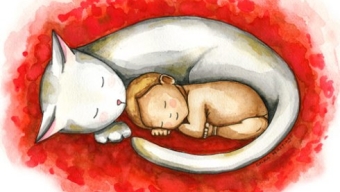by Jan Hunt, M.Sc., Director of The Natural Child Project
Nurturing a child’s love for learning begins with trust. As unschoolers, we trust our children to know when they are ready to learn and what they are interested in learning. We trust them to know how to go about learning. Parents commonly take this view of learning during the child’s first two years, when he is learning to stand, walk, talk, and to perform many other important and difficult things, with little help from anyone. No one worries that a baby will be too lazy, uncooperative, or unmotivated to learn these things; it is simply assumed that every baby is born wanting to learn the things he needs to know in order to understand and to participate in the world around him. These one- and two-year-old experts teach us several principles of learning:
Children are naturally curious and have a built-in desire to learn first-hand about the world around them.
John Holt, in his book How Children Learn, describes the natural learning style of young children:
“The child is curious. He wants to make sense out of things, find out how things work, gain competence and control over himself and his environment, and do what he can see other people doing. He is open, perceptive, and experimental. He does not merely observe the world around him. He does not shut himself off from the strange, complicated world around him, but tastes it, touches it, hefts it, bends it, breaks it. To find out how reality works, he works on it. He is bold. He is not afraid of making mistakes. And he is patient. He can tolerate an extraordinary amount of uncertainty, confusion, ignorance, and suspense. … School is not a place that gives much time, or opportunity, or reward, for this kind of thinking and learning.”1
Children know best how to go about learning something.
If left alone, children will know instinctively what method is best for them. Caring and observant parents soon learn that it is safe and appropriate to trust this knowledge. Such parents say to their baby, “Oh, that’s interesting! You’re learning how to crawl downstairs by facing backwards!” They do not say, “That’s the wrong way.” Perceptive parents are aware that there are many different ways to learn something, and they trust their children to know which ways are best for them.
Children need plentiful amounts of quiet time to think.
As John Holt noted in Teach Your Own, “Children who are good at fantasizing are better both at learning about the world and at learning to cope with its surprises and disappointment. It isn’t hard to see why this should be so. In fantasy we have a way of trying out situations, to get some feel of what they might be like, or how we might feel in them, without having to risk too much. It also gives us a way of coping with bad experiences, by letting us play and replay them in our mind until they have lost much of their power to hurt, or until we can make them come out in ways that leave us feeling less defeated and foolish.”2
But fantasy requires time, and time is the most endangered commodity in our lives. Fully-scheduled school hours and extracurricular activities leave little time for children to dream, to think, to invent solutions to problems, to cope with stressful experiences, or simply to fulfill the universal need for solitude and privacy.
Children are not afraid to admit ignorance and to make mistakes.
When Holt invited toddlers to play his cello, they would eagerly attempt to do so; schoolchildren and adults would invariably decline.
Unschooling children, free from the intimidation of public embarrassment and failing marks, retain their openness to new exploration. Children learn by asking questions, not by answering them. Toddlers ask many questions, and so do school children – until about grade three. By that time, many of them have learned an unfortunate fact: that in school, it can be more important for self-protection to hide one’s ignorance about a subject than to learn more about it, regardless of one’s curiosity.
Children take joy in the intrinsic values of whatever they are learning.
There is no need to motivate children through the use of extrinsic rewards, such as high grades or stars, which suggest to the child that the activity itself must be difficult or unpleasant; otherwise, why is a reward, which has nothing to do with the matter at hand, being offered? The wise parent says, “I think you’ll enjoy this book”, not “If you read this book, you’ll get a cookie.”
Children learn best about getting along with other people through interaction with those of all ages.
No parents would tell their baby, “You may only spend time with those children whose birthdays fall within six months of your own. Here’s another two-year-old to play with.”
John Taylor Gatto, New York State Teacher of the Year, contends, “It is absurd and anti-life to be part of a system that compels you to sit in confinement with people of exactly the same age and social class. That system effectively cuts you off from the immense diversity of life and the synergy of variety; indeed, it cuts you off from your own past and future….”3
A child learns best about the world through first-hand experience.
No parent would tell her toddler, “Let’s put that caterpillar down and get back to your book about caterpillars.” Unschoolers learn directly about the world. Our son describes unschooling as “learning by doing instead of being taught.” Ironically, the most common objection about unschooling is that children are “being deprived of the real world.”
Children need and deserve ample time with their family.
Gatto warns us, “Between schooling and television, all the time children have is eaten up. That’s what has destroyed the American family.”4 Many unschoolers feel that family cohesiveness is perhaps the most meaningful benefit of the experience. Just as I saw his first step and heard his first word, I have the honor and privilege of sharing my son’s world and thoughts. Over the years, I have discovered more from him about life, learning, and love, than from any other source. The topic we seem to be learning the most about is the nature of learning itself. I sometimes wonder who learns more in unschooling families, the parents or the children!
Stress interferes with learning.
Einstein wrote, “It is a very grave mistake to think that the enjoyment of seeing and searching can be promoted by means of coercion.”5 When a one-year-old falls down while learning to walk, we say, “Good try! You’ll catch on soon!” No caring parent would say, “Every baby your age should be walking. You’d better be walking by Friday!”
Most parents understand how difficult it is for their children to learn something when they are rushed, threatened, or given failing grades. John Holt warned that “we think badly, and even perceive badly, or not at all, when we are anxious or afraid… when we make children afraid, we stop learning dead in its tracks.”6
While infants and toddlers teach us many principles of learning, schools have adopted quite different principles, due to the difficulties inherent in teaching a large number of same-age children in a compulsory setting. The structure of school (required attendance, school-selected topics and books, and constant checking of the child’s progress) assumes that children are not natural learners, but must be compelled to learn through the efforts of others.
Natural learners do not need such a structure. The success of self-directed learning (unschoolers regularly outperform their schooled peers on measures of academic achievement, socialization, confidence, and self-esteem) strongly suggests that structured approaches inhibit both learning and personal development. Because unschooling follows principles of natural learning, children retain the curiosity, enthusiasm, and love of learning that every child has at birth.
Unschooling, as Holt writes, is a matter of faith. “This faith is that by nature people are learning animals. Birds fly; fish swim; humans think and learn. Therefore, we do not need to motivate children into learning by wheedling, bribing, or bullying. We do not need to keep picking away at their minds to make sure they are learning. What we need to do – and all we need to do – is to give children as much help and guidance as they need and ask for, listen respectfully when they feel like talking, and then get out of the way. We can trust them to do the rest.”7
1 Holt, John. How Children Learn (New York: Perseus Books Group, 1995), p. 287.
2 Holt, John. Teach Your Own (New York: Perseus Books Group, 2003), p. 128.
3 Gatto, John. Dumbing Us Down (Gabriola Island, BC: New Society Publishers), p. 24
4 Ibid., p.26.
5 Einstein, Albert. Autobiographical Notes, Open Court Publishing Company, 1991, p. 17.
6 Holt. How Children Learn, op. cit., p. xv.
7 Ibid., p. 293.
Article Source & Courtesy of Jan Hunt of The Natural Child Project
Jan Hunt, M.Sc., offers telephone counseling worldwide, with a focus on parenting, unschooling, and personal matters. She is the Director of The Natural Child Project and author of The Natural Child: Parenting from the Heart and A Gift for Baby.
Get more inspiring articles by Like’ing our Facebook Page Here >>





















